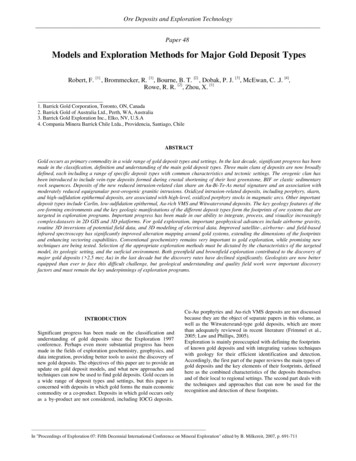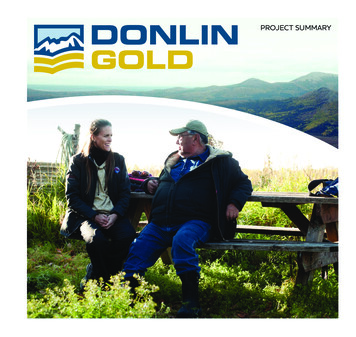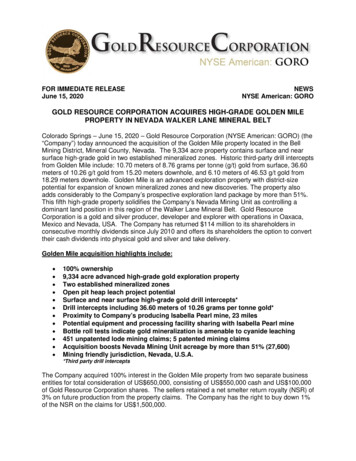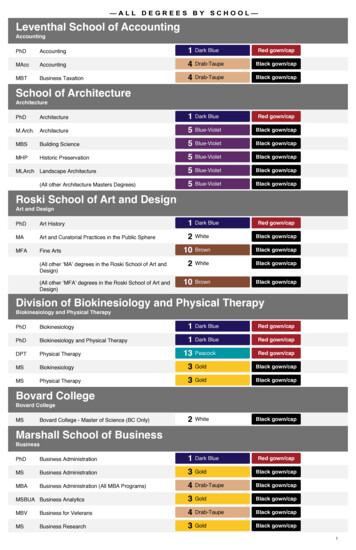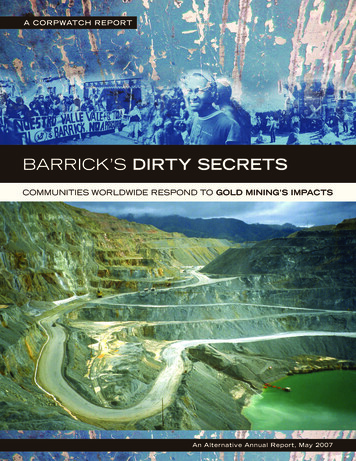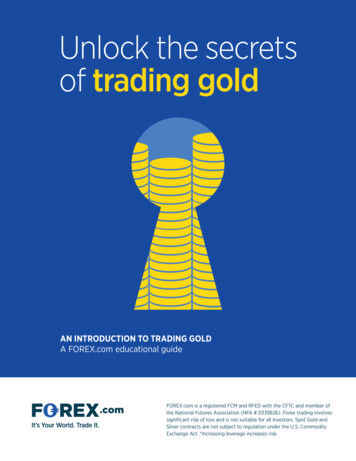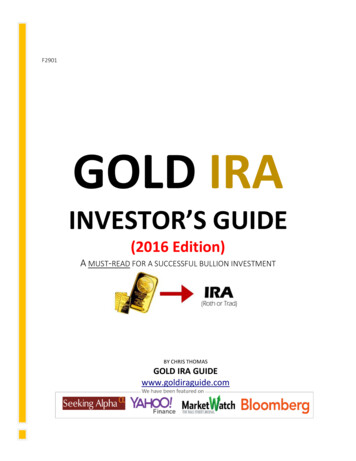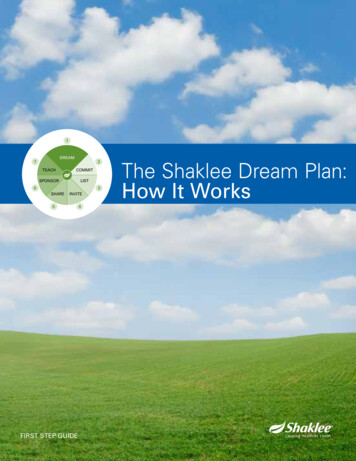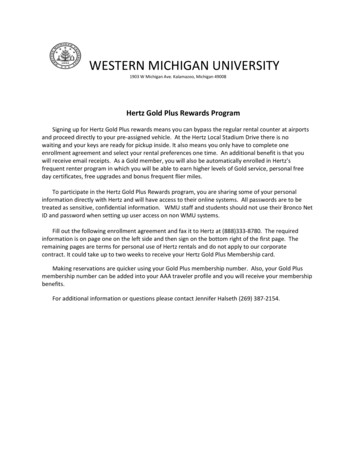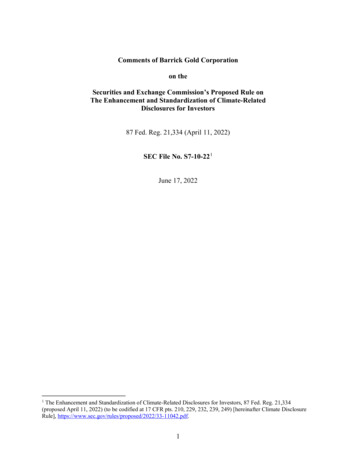
Transcription
Comments of Barrick Gold Corporationon theSecurities and Exchange Commission’s Proposed Rule onThe Enhancement and Standardization of Climate-RelatedDisclosures for Investors87 Fed. Reg. 21,334 (April 11, 2022)SEC File No. S7-10-22 1June 17, 2022The Enhancement and Standardization of Climate-Related Disclosures for Investors, 87 Fed. Reg. 21,334(proposed April 11, 2022) (to be codified at 17 CFR pts. 210, 229, 232, 239, 249) [hereinafter Climate DisclosureRule], df.11
I.IntroductionBarrick Gold Corporation (“Barrick”), appreciates the opportunity to respond to theSecurities and Exchange Commission’s (“SEC” or “Commission”) request for public commentregarding its proposed rule, The Enhancement and Standardization of Climate-Related Disclosuresfor Investors (the “Proposed Rule”), released on April 11, 2022.The Proposed Rule’simplementation of climate disclosures for information filed with the SEC are important to a broadrange of industries including the mining industry. We welcome the chance to share our insights,concerns, and suggestions.Barrick is an international mining company based in Toronto, Ontario, Canada with astrong corporate and operational presence in the United States. 2 Barrick’s global footprint is based,primarily, on its gold and copper production throughout the world. As one of the largest gold andcopper mining companies in the world, Barrick has a large presence in North America, with themajority of its North American mining operations located in Nevada. 3 Barrick’s copper productionextends throughout the Middle East, Africa, and Latin America. Barrick is also among a smallsubset of approximately 235 Canadian companies that are dual listed on both the New York StockExchange and the Toronto Stock Exchange. As a dual listed company, Barrick utilizes themultijurisdictional disclosure system (“MJDS”) and files its annual report with the SEC undercover of Form 40-F. As an MJDS filer with a global footprint, Barrick is uniquely positioned toBarrick’s global footprint extends to the United States, Canada, Dominican Republic, Guyana, Suriname, Peru,Chile, Argentina, Mali, Cote d’Ivoire, Senegal, Democratic Republic of the Congo, Tanzania, Zambia, Egypt, SaudiArabia, Papua New Guinea, and Japan. See BARRICK GOLD CORPORATION, ANNUAL REPORT 2021, at 5 (2021),https://s25.q4cdn.com/322814910/files/doc financial/annual reports/2021/Barrick Annual Report 2021.pdf[hereinafter ANNUAL REPORT].3The majority of Barrick’s interests in Nevada are held in the Nevada Gold Mines joint venture. Barrick is theoperator of the joint venture and owns 61.5%, with Newmont Corporation owning the remaining 38.5% of the jointventure. ANNUAL REPORT, supra note 2, at 74.22
comment on the Proposed Rule. In particular, Barrick wishes to address and advocate for theretention of the Proposed Rule’s exemption for Form 40-F filers. 4As a responsible member of the United States domestic and international miningcommunities, Barrick is committed to the promotion and implementation of sustainabledevelopment and operations. The minimization of environmental impacts, including operationaldecisions to address and minimize climate change, is one of the four pillars of Barrick’ssustainability strategy. 5 Further, transparency and openness are critical to Barrick’s sustainabilitystrategy which is one of the reasons why we are ranked in the 95th percentile of all miningcompanies assessed in the Dow Jones Sustainability Index’s World Index, with leading scores inenvironmental and social reporting and water risk management. 6 In light of our demonstratedcommitment to global sustainability, Barrick’s concerns regarding the Proposed Rule are lessabout the Proposed Rule’s underlying policy objectives or goals, and more about the practicaldifficulties of implementation for Barrick and similarly situated MJDS filers as well as thepotential long term counter-productive effects of the Proposed Rule. Indeed, Barrick alreadyprovides disclosures in alignment with the Task Force on Climate-Related Financial Disclosures(“TCFD”), included not just in Barrick’s voluntary Sustainability Report, but also in Barrick’sregulatory filings filed with the Canadian Securities Administrators and the SEC. 7In this comment letter, we address five broad concerns regarding the practical effects ofthe Proposed Rule that are acutely important to MJDS filers and mining companies generally.See Climate Disclosure Rule, supra note 1, Question 181, at 279.See BARRICK GOLD CORPORATION, SUSTAINABILITY REPORT 2021, at 14 (2021),https://s25.q4cdn.com/322814910/files/doc downloads/sustainability/Barrick Sustainability Report 2021.pdf[hereinafter SUSTAINABILITY REPORT].6See SUSTAINABILITY REPORT, supra note 5, at 6.7See e.g. Management’s Discussion and Analysis for the year ended December 31, 2021 beginning on page 34under the heading “Climate Change” (filed as exhibit 99.4 on Form 40-F), and the Annual Information Form for theyear ended December 31, 2021 beginning at page 53 under the heading “Climate Resilience” (filed as exhibit 99.1on Form 40-F).453
First, the Proposed Rule should maintain the exemption for MJDS filers, and go further to providealternative compliance options for issuers utilizing existing climate change reporting frameworksin their home countries. Second, if for some reason the MJDS exemption is not preserved and theProposed Rule applies to Barrick, the Proposed Rule’s requirements for the assessment of physicalclimate risks and the impacts on financial statements present many novel issues and will bechallenging to implement and as a result more time will be needed to come into compliance withthe Proposed Rule. Third, the Proposed Rule lacks sufficient guidance for issuers to calculateGreenhouse Gas (“GHG”) emissions for disclosure in regulatory filings. Fourth, the attestationrequirement is unreasonably onerous. And fifth, the Proposed Rule may hinder progress onclimate related mitigation due to a decreased desire for sustainability reporting in a regulatedmarketplace. We strongly urge the SEC to allow market forces to drive the climate changereporting that is already provided to investors by way of regulatory filings, voluntary sustainabilityreporting, and mandated Environmental Protection Agency (“EPA”) GHG emission reporting.The Proposed Rule, as drafted, provides insufficient guidance for compliance and does not allowsufficient time for companies to implement the new and more specific internal controls andprocedures required to satisfy the new climate-related reporting obligations.II.The Proposed Rule Is Particularly Burdensome On Filers With ObligationsUnder Multiple Jurisdictions.Barrick is in a unique position to comment on the Proposed Rule because we file underthe MJDS using documents prepared in accordance with Canadian securities laws to registersecurities under the Securities Act and report under the Exchange Act in the United States.Barrick’s understanding of the Proposed Rule is that MJDS filers, like Barrick, would not besubject to the disclosure requirements in the Proposed Rule and will therefore continue to rely ontheir Canadian filings to satisfy their Exchange Act reporting obligations. The MJDS has been in4
effect for decades and streamlines Exchange Act reporting obligations for eligible Canadianentities, causing more Canadian companies to list on U.S. stock exchanges and increasing accessand liquidity for U.S. investors. Just as MJDS filers are not subject to the new mining rulesunder Regulation S-K 1300 because of the robust protections provided to investors underCanada’s National Instrument 43-101, we strongly believe that MDJS filers should not be subjectto the Proposed Rule in light of Canada’s anticipated climate disclosure rules. 8 The long-timedeference shown by the SEC to Canadian reporting standards and regulatory review, whichunderpins the MJDS, should apply with equal force here as well. We strongly encourage theSEC to maintain this exemption under the Proposed Rule.In addition to maintaining the exemption for MJDS filings, the SEC should include inany final rule the ability for issuers to rely on alternate reporting regimes for disclosure of GHGemissions and climate risks. There are a number of robust reporting methodologies andvoluntary disclosure frameworks, some of which were borrowed from for certain aspects of theProposed Rule. These include the TCFD, the Greenhouse Gas Protocol, the CDP (formerly theCarbon Disclosure Project), the Global Reporting Initiative, the International SustainabilityStandards Board (“ISSB”), the International Organization for Standardization, and others. As analternative compliance option for companies already reporting under these methodologies andframeworks, the SEC should provide an option in the final rule that would allow companies whohave adopted one of these reporting frameworks for climate related disclosures, to satisfy thefinal rule with those disclosures. For example, we believe that a company that reports pursuantto the TCFD should be able to simply use that information to satisfy the Proposed Rule. TheseCanadian Securities Administrators, Proposed National Instrument 51-107: Disclosure of Climate-Related Matters(Oct. 18, 2021), st-comment-proposed [hereinafter Proposed NationalInstrument 51-107].85
frameworks are well established and adopted by many companies. Such an alternativecompliance option would provide stability and reduce unnecessary expense for companies thathave already established a system to report under these frameworks, and would allow investorsto continue to follow, compare and track reporting under that same framework.Concerns regarding duplicative reporting, and related costs and inefficiencies, wereeffectively addressed by the Commission in the recently adopted final rules relating to disclosureof government payments by resource extraction issuers (the "Government Payments Rules"). Weencourage a similar approach here. For issuers subject to reporting in multiple jurisdictions, therewas a concern regarding duplication of reporting. In order to address this concern, theCommission permitted use of alternative reporting under certain circumstances.The Government Payments Rules provide that a "resource extraction issuer that is subjectto the resource extraction payment disclosure requirements of an alternative reporting regimethat has been deemed by the Commission to be substantially similar to the requirements of Rule13q-1 . may satisfy its disclosure obligations . by including .a report complying with thereporting requirements of the alternative jurisdiction." Both the EU Directives and the ExtractiveSector Transparency Measures Act (“ESTMA”) in Canada have been recognized as substantiallysimilar disclosure regimes for purposes of alternative reporting.We believe allowing alternative reporting using the same "substantially similar" standardthat was used in the Government Payments Rules would be an appropriate way to addressconcerns related to increased costs and inefficiencies resulting from duplicative reporting undersimilar, but different standards in the United States and Canada, for example. We believe itwould be consistent with the desire to enhance investor disclosure while reflecting aconsideration of competition, efficiency, capital formation, and costs if the final rules permitted6
alternative reporting in the same manner as the Government Payments Rules, including use ofthe Form SD for the filing of the alternative reporting.If the SEC decided not to preserve the exemption for MJDS issuers in the final rule, it isalmost certain that companies like Barrick would be in a situation where they would reportcertain climate information in their home jurisdiction, and be simultaneously required to reportpotentially different climate related information in the United States that may conflict inpresentation format or substance with its Canadian reporting, or require different data-gatheringand verification procedures that could create significant burdens or inefficiencies. Canada’sproposed climate disclosure rules do not follow the same climate risk and emission impactframework as set out in the Proposed Rule. 9 If Canada adopts a climate related disclosureframework based on TCFD, we believe investor concerns in the U.S. should be adequatelyaddressed although there would likely be some differences in the reporting requirements.Requiring companies to comply with similar, but not identical, reporting requirements increasesthe costs of compliance without increasing the quality of disclosure to investors. We believe itmakes little sense, and would be contrary to the intent of the rule—to better inform investors—torequire companies to prepare separate filings, applying different standards, to satisfy slightlydisparate jurisdictional rules. The SEC should consider accepting the reporting compiled underthese alternative frameworks to satisfy reporting obligations under the Proposed Rule.III.The Proposed Rule Sets a Difficult and Unrealistic Standard for Climate Risksand Impacts on Financial Statements.The Proposed Rule includes a number of “Climate-related metrics” that must be assessedand disclosed in annual reports and reflected in financial statements. These include both positiveand negative financial impacts due to climate transition activities or extreme weather events and9Proposed National Instrument 51-107, supra note 8.7
any estimates, assumptions, or expenditures assessed on a line by line basis in the financialstatements due to such transition activities or climate impacts, including extreme weatherevents. 10 The threshold for triggering disclosure under the Proposed Rule is if the impact on anyline item is greater than 1% of the total line item for the fiscal year. 11 On the surface, this seemslike a logical way to assess how a company is impacted by climate change, and what thecompany is doing to manage its resources to address those impacts. However, there are anumber of difficulties with the SEC’s proposed climate risk disclosure approach.First, companies may not have access to the information they need to report on theimpacts of climate change on a financial statement line-item basis, or they may lack the ability toquantify the risk with the information they do have. For example, what is the financial risk forwildfire damage to mining operations on land owned by the Federal Government, and howshould a company calculate the potential liability to reflect that risk? The company has nocontrol over fire prevention measures on lands it does not own, and mitigation of that risk coulddepend on a multitude of factors the company cannot predict. Therefore, the decision to includethe risk in financial disclosures becomes entirely subjective based on assumptions about whetherthe line item is affected. Something so subjective should not carry the weight of legal liability.Nor does it provide reliable information to investors that is comparable to information disclosedby other companies, in part because all companies will need to adopt highly subjective andbespoke accounting policies to comply with the Proposed Rule.If the risk cannot be quantified because the information is not available, how can thedetermination be made whether it exceeds the 1% threshold? If a company like Barrick, which isboth committed and invested in mitigating climate risk, and has resources to make informed1011See Climate Disclosure Rule, supra note 1, § 210.14-02, at 452–55.See Climate Disclosure Rule, supra note 1, § 210.14-02, at 453.8
decisions about its financial statements, is struggling to understand how to comply with thisaspect of the Proposed Rule, a natural question is how will other companies with fewer resourcesever be able to comply? And, the risks of non-compliance are significant. If the SEC determinesthat a disclosure or financial statement note is lacking or inaccurate, Barrick could be required torestate its financial statements setting off a chain reaction of adverse consequences includingpotential shareholder class action litigation, SEC enforcement action, and the recoupment ofexecutive compensation.Similarly, the requirement to assess climate related risks on a company and itsconsolidated financial statements on short-, medium-, and long-term timeframes 12 also posesdifficulty and creates uncertainty for registrants, including Barrick. This is especially true withrespect to the long-term timeframe. The number of climate related scenarios that could impactbusiness operations or financial statements that could be predicted beyond 10 years is infinite.The longer the time period evaluated, the less certainty there is to assess climate related risks andimpacts. Yet, despite this uncertainty, the Commission would require financial statements toinclude disclosures that are based on these infinitely variable scenarios.The Proposed Rule is also unclear about how broadly the Commission intends to requirethese speculative risk assessment disclosures to extend. For example, if there is a climate relatedrisk for flooding to a mining operation because storms might exceed the traditional 100-yearstorm event that most mines have been designed to accommodate, the mining company couldlikely predict the physical impacts to operations and/or capital repairs that might be required dueto the flood, and these impacts could be reflected in financial statement notes. In effect, these areon-site impacts that can more readily be measured and quantified. However, if the impacts to the12See Climate Disclosure Rule, supra note 1, § 229.1502, at 463.9
mining operations also cause damage to local communities, there is the risk of political unrestand protests by local residents that will likely cause indirect impacts on the mine, in other words,off-site impacts. It is unclear whether the Proposed Rule would require disclosure of such offsite impacts, in addition to the on-site impacts, both of which could impact the viability of themining operation. Again, the scope of potential business impacts are very difficult to define, andcannot be predicted with the certainty that is necessary for inclusion in financial statements.Not only is it problematic that a company may not have the information necessary for itto properly make these climate risk disclosures and financial statement notes, and will need todecide what to disclose out of the infinite number of possible risks in long term climate riskanalyses, but a company’s auditors will also require an objective standard in order to audit theinformation a company ultimately includes in its financial statements, which the Proposed Rulefails to provide. With so much complexity and subjectivity surrounding these disclosures infinancial statements, these issues may well rise to the level of critical audit matters for acompany’s auditors.The second difficulty with the climate risk approach in the Proposed Rule is that it isnearly impossible to consistently tease out the true impact of a situation attributable to climatechange as compared to the impact attributable to other business drivers. If Barrick were to makeimprovements to a tailings impoundment, for example, how much of that decision is attributableto climate change risks in the form of extreme weather impacts on the impoundment? What ifthe improvements were required by a state regulator? What if the improvements madeoperations run more smoothly thereby enabling higher production targets? Barrick is left tomake an assumption about how much a decision is driven by climate change, and the particularfinancial impact of that driver. There are many aspects of the mining business that could10
arguably be attributable to a climate change metric, but it is unclear how to make thatdetermination when, as is often the case, there are multiple reasons for the same businessdecision. Adopting accounting policies to address these types of decisions will requireextensive effort and may still ultimately be arbitrary, which would leave registrants vulnerable tobeing second-guessed and make it unlikely that investors will receive useful, comparableinformation across registrants.Barrick is also concerned about the disclosure threshold of 1% of the financial statementline item. 13 This is a very conservative bright-line threshold that may not be reasonable in allsituations and ignores customary principles of materiality, which do not apply thresholdpercentages on a line item basis and may or may not use 1% as the materiality threshold.Companies should have the leeway to make materiality determinations on a case-by-case basis,taking into consideration what is appropriate for the particular situation. Moreover, the 1%threshold may not align with other materiality thresholds applied elsewhere in the financialstatements. This raises a concern that other internal materiality thresholds applied by a companyare not appropriate if they deviate from a 1% threshold. Why should a company be required toapply a 1% threshold to all line items within its financial statements just because the ProposedRule requires it for purposes of the analysis of climate related risks and impacts?Given this uncertainty, registrants are likely to err on the side of disclosing and reportingnumerous climate risk notes on financial statements, irrespective of whether other factors areactually driving the financial expenditures or reserves, in an effort to ensure that they do not runafoul of the Proposed Rule. This likely will lead to an overwhelming volume of information forinvestors. It will not provide any distinguishable metrics to inform an investor about a company,13See Climate Disclosure Rule, supra note 1, § 210.14-02(b)(1), p. 452–453.11
other than the company’s interest in maintaining compliance with SEC disclosure rules. Such anoutcome is not useful, nor in line with the SEC’s stated goals for the Proposed Rule.IV.The GHG Emission Reporting Requirements Should be Narrowed.The Proposed Rule requires disclosures of three types of GHG emissions; Scope 1emissions, which are those that the registrant directly emits as part of its operation; Scope 2emissions, which are those that are emitted by the generation of purchased or acquiredelectricity, steam, heat, or cooling that is consumed by the registrant; and Scope 3 emissions,which occur in the upstream and downstream activities of a registrant’s value chain. 14 Barrickalready reports these emissions under the TCFD framework, and will continue to disclose themunder the Canadian climate rules once finalized. So, Barrick’s concern is less about whether ornot to disclose these emissions, and more about the need for alternative options for reporting thatmake sense for companies in the commodity minerals market.First, the Commission does not need to reinvent the wheel with respect to frameworks forreporting these GHG emissions. There are a number of frameworks that many companies havealready adopted, as referenced in the prior section of this comment letter. The GHG emissionsreported under these frameworks should suffice for compliance with the SEC’s Proposed Rule.These frameworks have been refined to accommodate needs of specific industries and companiesto produce reporting that makes sense to investors and is reliable. The Proposed Rule does notprovide any more specific metrics for quantifying and measuring these emissions than existingregulatory requirements or voluntary frameworks, so reporting under the Proposed Rule wouldnot garner any more clarity on GHG emissions than what companies already report and investors14See Climate Disclosure Rule, supra note 1, § 229.1500(p)–(r), at 460.12
already receive. 15 To the extent companies are already following these other frameworks andprotocols, the SEC should allow continued use and reporting under those programs to satisfyU.S. reporting requirements.Second, with respect to Scope 3 emissions, the Proposed Rule should recognize theunique position that a commodities producer, like Barrick, is in, with respect to disclosingdownstream value chain reporting. In its current reporting of Scope 3 emissions, Barrickaccounts for the GHG emissions associated with its gold or copper that is delivered to smeltersfor further refining and distribution, and a limited amount of metals recycling. It does not track,nor should it be required to track, where the gold or copper ends up in final products. TheProposed Rule does not address the situation of commodities, and how far down the chain shoulda company like Barrick have to report. For example, does Barrick have to account for all of theenergy and GHG emissions that result from the production of a smartphone that uses gold in itsmicrochips? What about the energy and associated emissions used to charge each smartphone—are those counted too? If such emissions are to be counted under the Proposed Rule, it wouldlead to an enormous increase in the amount of emissions data reported but a decrease in thatdata’s reliability and utility. Moreover, it is not a reasonable characterization of the climateimpact that a gold mining company truly has when its mined material comprises such aminiscule part of an end product. Finally, most gold is either held indefinitely or recoveredthrough recycling. As such, the time dimension to the extent of Scope 3 emissions is potentiallyendless for a company like Barrick.See Climate Disclosure Rule, supra note 1, at 195 (allowing for registrant to choose how it measures GHGs forScope 2 – either by location based method or by emission factor directly); see also id. at 198 (by way of example,the SEC proposes to allow for estimates for fourth quarter emissions to meet filing deadlines).1513
Similarly, if you consider the production of copper, which is used in an extremely broadrange of downstream products, these calculations get even more unwieldy. Copper smelters comingle copper in concentrate form received from multiple mining companies which means thesubsequent tracing of the end use of such metal is highly problematic. Even with the safe harborprovisions for Scope 3 emissions, this obligation to calculate GHG emissions down the supplychain could be a cumbersome and ultimately inaccurate obligation for commodities producerslike Barrick. We therefore urge the SEC to recognize the unique position of commoditiesproducers and provide a clear boundary for assessing downstream Scope 3 emissions—at thesmelting or refining stages of those commodities operations, or permit the use of alternativereporting regimes such as the GHG Protocol or the TCFD to satisfy the Proposed Rule.V.The Attestation Requirement Creates Timing and Availability Issues Resultingin Liability Risks.The attestation requirement for Scope 1 and Scope 2 emissions creates difficulties relatedto timing and availability of qualified professionals to perform the attestation. In the first quarterof any year, companies are busy compiling, calculating, and validating emissions data for variousreporting purposes. It is already quite challenging to complete this process by mid to late Marchin time to meet existing reporting deadlines. These regulatory obligations include therequirement to report GHG emissions to the EPA under the Clean Air Act. In 2009, EPApromulgated mandatory GHG reporting requirements under 40 C.F.R. Part 98. EPA estimatesthat over 85-90% of all GHG emissions in the United States are already being reported underEPA’s rule. 16 This is certainly true for Barrick, which estimates that substantially all of its GHGemissions from all of its operations are reported to the EPA.Barrick is concerned that issuersSee EPA, FACT SHEET: GREENHOUSE GASES REPORTING PROGRAM IMPLEMENTATION 4-09/documents/ghgrp-overview-factsheet.pdf.1614
would be unable to have a qualified professional attest to the accuracy of these emissionsnumbers in time to meet SEC’s proposed reporting timeline, thereby rendering that issuer’sreporting deficient or potentially inaccurate. 17 This is made even more difficult due to the SEC’sproposed rapid implementation. If the proposed rules were effective by the end of 2022, largeaccelerated filers would be required to disclose Scope 1 and 2 information in their annual reportsfor 2023 (which are filed in early 2024), with a requirement for a limited assurance attestation tobegin the following year. This provides a limited window for larger accelerated filers toestablish the necessary additional controls and procedures to satisfy an attestation review for thenew and specific climate related disclosure requirements. We note that the Conflict Mineralrules adopted in 2012 provided a two-year transition period for larger issuers before anattestation was required of certain conflict mineral reports, and we urge a similar or longertransition period be adopted here. 18 Simply put, more time is needed to incorporate anattestation requirement on top of these other compliance efforts.As an alternative to GHG reporting under the Proposed Rule, the SEC could encouragethe EPA to broaden the scope of its GHG reporting rule to capture a broader universe of GHGemitters and require that any missing sector to report GHG emissions under the EPA’s rules. Ifthe SEC continues to feel that compiling this emission information to be contained in an SECfiling which is readily available to investors at no charge, we propose that the SEC permit issuersto furnish the information provided to the EPA as an exhibit to its annual filings or under coverof Form SD (which is where conflict mineral reporting is, and government payments reportingby extractive issuers will be, filed). This would allow investors to have a more easily obtainabledata set in its SEC reportin
The majority of Barrick's interests in Nevada are held in the Nevada Gold Mines joint venture. Barrick is the operator of the joint venture and owns 61.5%, with Newmont Corporation owning the remaining 38.5% of the joint venture. A. NNUAL . R. EPORT, supra . note 2, at 74.
